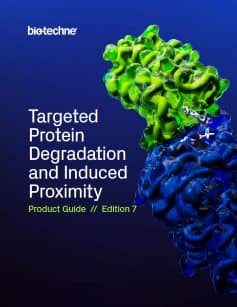TAG Degradation Platform
The TAG Degradation Platform (dTAG/aTAG/BromoTag®) is a TPD based approach to target validation that uses a heterobifunctional Degrader targeting a fusion protein. This technology allows rapid and highly selective degradation of a protein of interest, and is generalizable to a range of fusion proteins. It is useful as an alternative to genetic methods for target validation and can be used in cell culture or in vivo. The TAG system has potential for validation of targets for which there are no known ligands.
Degraders |
|
| Cat. No. | Product Name / Activity |
|---|---|
| 7893 | 5-Ph-IAA-AM |
| Selective and potent TAG Degrader for auxin-inducible degron 2 system; 5-Ph-IAA analog | |
| 6970 | aTAG 2139 |
| Degrader of MTH1 fusion proteins for use within the aTAG system | |
| 6971 | aTAG 4531 |
| Degrader of MTH1 fusion proteins for use within the aTAG system | |
| 7686 | BromoTag® AGB1 |
| Potent and selective Degrader of Brd4BD2 L387A fusion proteins (BromoTag®) | |
| 7688 | BromoTag® AGB3 |
| Selective Degrader of Brd4BD2 L387A fusion proteins (BromoTag®) | |
| 6605 | dTAG-13 |
| Degrades mutant FKBP12F36V fusion proteins; useful alternative to genetic methods for target validation | |
| 7530 | dTAG-47 |
| Degrades mutant FKBP12F36V fusion proteins; useful alternative to genetic methods for target validation | |
| 6912 | dTAG-7 |
| First generation Degrader for mutant FKBP12F36V fusion proteins; useful alternative to genetic methods for target validation | |
| 6914 | dTAGV-1 |
| Potent and selective degrader of mutant FKBP12F36V fusion proteins | |
| 7374 | dTAGV-1 hydrochloride |
| Hydrochloride salt of dTAGV-1 (Cat. No. 6914); suitable for in vivo use | |
| 7392 | 5-Ph-IAA |
| Selective and potent TAG Degrader for auxin-inducible degron 2 system | |
| 7669 | XY-06-007 |
| Potent and selective Degrader of Brd4BD1 L94V fusion proteins | |
Controls |
|
| Cat. No. | Product Name / Activity |
| 7575 | aTAG 2139-NEG |
| Negative control for aTAG 2139 (Cat. No. 6970) | |
| 7687 | BromoTag® cis-AGB1 |
| Negative control for BromoTag® AGB1 (Cat. No. 7686) | |
| 6916 | dTAG-13-NEG |
| Negative control for dTAG-13 (Cat. No. 6605) | |
| 7531 | dTAG-47-NEG |
| Negative control for dTAG-47 (Cat. No. 7530) | |
| 6915 | dTAGV-1-NEG |
| Negative control for dTAGV-1 (Cat. No. 6914) | |
Other |
|
| Cat. No. | Product Name / Activity |
| 6207 | AP 1867 |
| Selective binding ligand for FKBP12F36V | |
| 8102 | dTAG Janelia Fluor® 525 |
| Fluorogenic srTAG probe for live cell imaging of FBKP12 (F36V/L) fusion proteins | |
| 8103 | dTAG Janelia Fluor® 585 |
| Fluorogenic srTAG probe for live cell imaging of FBKP12 (F36V/L) fusion proteins | |
| 8101 | dTAG Janelia Fluor® 635 |
| Fluorogenic srTAG probe for live cell imaging of FBKP12 (F36V/L) fusion proteins | |
| 7883 | dTAG-Biotin |
| Affinity probe for mutant FKBP12F36V proteins | |
| 7892 | dTAG-Fluorescein |
| Fluorescent probe for labeling mutant FKBP12 (F36V) proteins | |
| 7787 | Ortho AP 1867 |
| Selective binding ligand for FKBP12F36V; precursor for dTAG compounds | |
The TAG Degradation Platform enables the knockdown of your protein of interest (POI) by adding a tag (or degron tag), via genetic modification, which can then be targeted by a small molecule Degrader.
The dTAG technique involves the expression of a protein of interest as a fusion with mutant FKBP12F36V via transgene expression or CRISPR-mediated locus-specific knock-in. dTAG Degraders are heterobifunctional, comprising a synthetic ligand (AP1836), that selectively binds FKBP12F36V linked to an E3 ligase ligand, such as Thalidomide. The dTAG Degrader recruits the fusion protein to the E3 ligase complex, bringing about its ubiquitination and subsequent degradation by the proteasome.
In the aTAG (Achilles TAG) system, the protein of interest is expressed as a fusion with the enzyme MTH1 (MutT homolog-1; NUDT1). MTH1 is used as the TAG since there is no known phenotypic consequence resulting from the loss of this protein. The aTAG Degrader comprises a ligand selective for MTH1 linked to an E3 ligase ligand. As with dTAG, aTAG Degraders provide potent and rapid degradation of the fusion protein, and have a range of properties suitable for in vitro and in vivo applications. For more information on the CRIPSR-mediated knock-in of MTH1 fusion proteins, see accompanying Protocol.
The BromoTag platform uses Brd4BD2 L387A, a variant of the BET bromodomain BRD4, as the tag fused to the target POI. The BromoTag Degrader comprises a VHL E3 ligase ligand joined by a linker to a (+)-JQ1 (Cat. No. 4499) derivative that selectively binds the Brd4BD2 L387A variant.
TAG Technology for Target Validation

Figure 1: Schematic showing the mode of action of TAG Degraders. A protein of interest is expressed as a fusion with a "TAG" protein. For the dTAG system the protein of interest is tagged with F36V single-point mutated FKBP12; the aTAG system uses MTH1 as the TAG; and in the BromoTag system the POI is tagged with a BRD4BD2 L387A variant. The dTAG/aTAG Degrader initiates the formation of a ternary complex between an E3 ubiquitin ligase and the fusion protein which results in polyubiquitination of the target protein, its recognition by the proteasome and subsequent degradation of the entire protein. dTAG/aTAG molecules act catalytically, repeatedly engaging and directing the ubiquitination of target molecules.
Plasmid vectors for the lentiviral expression and CRISPR-mediated knock-in of FKBP12F36V are available from Addgene.
BromoTag® is a registered trademark of the University of Dundee and is used under license.

Literature for TAG Degradation Platform
Tocris offers the following scientific literature for TAG Degradation Platform to showcase our products. We invite you to request* your copy today!
*Please note that Tocris will only send literature to established scientific business / institute addresses.
TPD and Induced Proximity Research Product Guide
This brochure highlights the tools and services available from Bio-Techne to support your Targeted Protein Degradation and Induced Proximity research, including:
- Active Degraders
- TAG Degradation Platform
- Degrader Building Blocks
- Assays for Protein Degradation
- Induced Proximity Tools
Targeted Protein Degradation Poster
Degraders (e.g. PROTACs) are bifunctional small molecules, that harness the Ubiquitin Proteasome System (UPS) to selectively degrade target proteins within cells. They consist of three covalently linked components: an E3 ubiquitin ligase ligand, a linker and a ligand for the target protein of interest. Authored in-house, this poster outlines the generation of a toolbox of building blocks for the development of Degraders. The characteristics and selection of each of these components are discussed. Presented at EFMC 2018, Ljubljana, Slovenia


